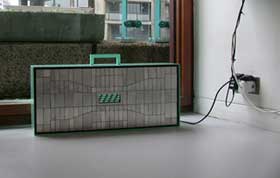The roadside environment - where the tarmac stops and the grass embankment begins - is full of the detritus of city commuters, and rich in plant and animal life thriving in the nitrogenous air.
The cellular noise-maker is one of the noise farming devices that capture the ethereal turbulence of these roadside ecosystems, transmit these samples in data streams, or display them in light patterns.

The portable steel box is comprised of a fluorescent display surrounded by aluminium flexible flaps. It can be carried around, keeping the house's occupants company. As data is received by the device from other noise farming devices, it is stored in its memory and shown as an intricate pattern of dots on the central display.
When its memory is full, the noise-maker uses its stored data patterns as a score to generate a sound burst of many simultaneous clicking noises by using electromagnets to rapidly move the flaps on its surface. The clicking noise ends in a sharp FM radio pulse which is a highly compressed data burst of all its memory contents. Following this, the memory is wiped and the process starts again.
Video of the cellular moise-maker in noisy action.
Part of the Edge Town Project by Ben Hooker and Shona Kitchen.

